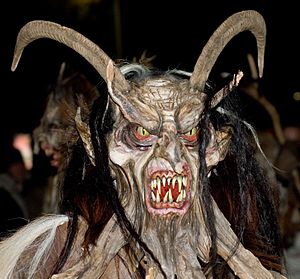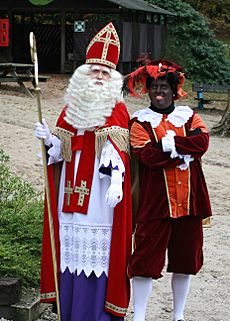Companions of Saint Nicholas facts for kids
The companions of Saint Nicholas are special characters who travel with Saint Nicholas in many countries, especially those that were once part of the Holy Roman Empire. These companions are like a contrast to kind Saint Nicholas. While he gives gifts to good children, the companions might threaten or scold children who haven't behaved well.
Many of these characters are linked to old stories about house spirits or elves from before Christianity. These spirits could be helpful or mischievous. After Christianity spread, their mischievous side became more important.
Some names for these "dark" or strict companions include:
- Knecht Ruprecht in Germany
- Krampus in Austria, Bavaria, Slovenia, Croatia, and Hungary
- Klaubauf in Bavaria and Austria
- Bartel in Styria
- Pelzebock
- Befana
- Pelznickel
- Belzeniggl
- Belsnickel in the Palatinate region of Germany and also in Pennsylvania in the USA
- Schmutzli in Switzerland
- Rumpelklas
- Bellzebub
- Hans Muff
- Drapp
- Buzebergt in Augsburg
In the Netherlands and Flanders, the companion is called Zwarte Piet or Black Pete. In the Czech Republic, Saint Nicholas (svatý Mikuláš) is joined by the čert (Devil) and anděl (Angel). In France, Saint Nicholas's companion is called "Rubbels" in German-speaking Lorraine and Hanstrapp (in Alsace, East of France) and the Père Fouettard (in Wallonia, Northern and Eastern France).
Appearance
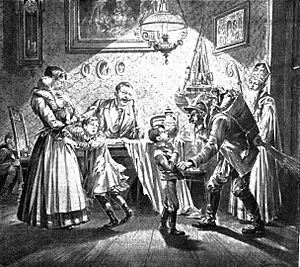
The companions of Saint Nicholas often appear in winter stories. They travel with Saint Nicholas, carrying a rod or stick and a sack. Sometimes they wear black rags, have black faces, and messy black hair. In many modern pictures, they look like a darker, scarier, or more rustic version of Saint Nicholas himself, wearing similar clothes but in darker colors.
Knecht Ruprecht
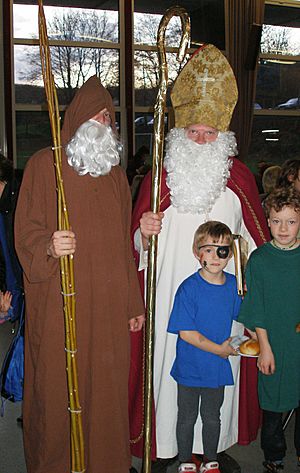
In German folklore, Knecht Ruprecht means Farmhand Rupert or Servant Rupert. He is a well-known companion of Saint Nicholas. Stories say he is a man with a long beard, dressed in fur or covered in straw. Knecht Ruprecht sometimes carries a long staff and a bag of ashes, and wears small bells on his clothes.
Traditionally, Knecht Ruprecht asks children if they know their prayers. If they do, they get apples, nuts, and gingerbread. If they don't, he might tap them with his bag of ashes. In more modern stories, Knecht Ruprecht gives naughty children gifts like lumps of coal, sticks, or stones. Well-behaved children get sweets from Saint Nicholas. He might also leave a stick in naughty children's shoes instead of candy.
The name Ruprecht was a common name for the devil in Germany. Knecht Ruprecht first appeared in written records in the 1600s, as part of a Christmas parade in Nuremberg.
Sometimes, Ruprecht walks with a limp because of an old injury. His black clothes and dirty face are often said to be from the soot he collects when going down chimneys. In some traditions, children would perform a dance or sing a song for Santa and Ruprecht to show they were good. Those who performed well received a gift. Those who performed badly or were naughty might be put into Ruprecht's sack and taken away. In other stories, children must be asleep and wake up to find their shoes filled with sweets, coal, or a stick.
Krampus
Krampus is a scary figure found in parts of Austria, Bavaria, South Tyrol, Slovenia, and Croatia. He likely comes from old traditions in the Alps. In Tyrol, he is also called "Tuifl".
The Feast of Saint Nicholas is celebrated on December 6 in parts of Europe. On the evening before, called Krampusnacht (Krampus Night), the hairy devil appears on the streets. He sometimes comes with Saint Nicholas. However, Krampus will sometimes visit homes and businesses by himself. Saint Nicholas gives gifts, while Krampus brings coal and bundles of birch branches.
People in Europe have been sending Krampuskarten, which are greeting cards with Krampus on them, since the 1800s. A Krampuslauf is a parade where people dress up as the beast. This is still very popular, with many participants enjoying a drink called schnapps. More than 1200 "Krampus" figures gather in Schladming, Styria, from all over Austria. They wear goat-hair costumes and carved masks, carrying bundles of sticks and swinging cowbells to announce their arrival.
Belsnickel
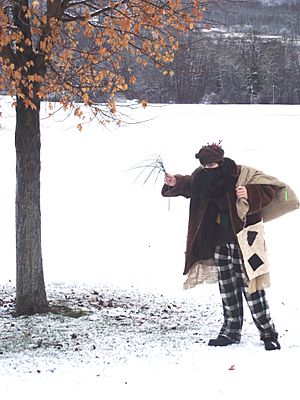
Belsnickel is a companion of Saint Nicholas in the Palatinate region of Germany. Belsnickel is a man covered in fur, and he sometimes wears a mask with a long tongue. He is a rather scary creature who visits children at Christmas time. He delivers socks or shoes full of candy, but if the children were not good, they will find coal in their stockings instead.
In some parts of the United States in the 1800s, "Pelznickel" traditions were kept alive by immigrants, especially in Pennsylvania. Today, parts of this tradition remain, known as the Belsnickel.
An old story from the 1830s in Allegany County, Maryland, describes the "Beltznickle" tradition. The writer, Jacob Brown, said they didn't know about Santa Claus then. Instead, a different character would visit:
He was known as Kriskinkle, Beltznickle and sometimes as the Xmas woman. Children then not only saw the mysterious person, but felt him or rather his stripes upon their backs with his switch. The annual visitor would make his appearance some hours after dark, thoroughly disguised, especially the face, which would sometimes be covered with a hideously ugly phiz – generally wore a female garb – hence the name Christmas woman – sometimes it would be a veritable woman but with masculine force and action. He or she would be equipped with an ample sack about the shoulders filled with cakes, nuts, and fruits, and a long hazel switch which was supposed to have some kind of a charm in it as well as a sting. One would scatter the goodies upon the floor, and then the scramble would begin by the delighted children, and the other hand would ply the switch upon the backs of the excited youngsters – who would not show a wince, but had it been parental discipline there would have been screams to reach a long distance.
This means the visitor, disguised and sometimes looking scary, would throw treats on the floor for children to grab. At the same time, they would gently tap the children's backs with a switch.
On the South Shore of Nova Scotia, Canada, there is a Christmas tradition called Belsnickling. Like "mummering," people go from house to house dressed in many layers of clothes and with scarves covering their faces to hide who they are. These people are given food and drinks until their identities are guessed. Then they move on to the next house.
Zwarte Piet (Black Pete)
Zwarte Piet (meaning Black Peter or Black Pete in English, and Père-Fouettard or father whipper in French) is the companion of Saint Nicholas (Dutch: Sinterklaas) in the folklore of the Low Countries. Recently, the character's name has been changed to Roetveeg Piet, which means "soot wipe pete". This version has only smudges of black make-up, to make it less offensive.
The character first appeared in his current form in an 1850 book. Traditionally, Zwarte Piet was said to be black because he was a Moor from Spain. People playing Zwarte Piet often painted their faces black, wore bright red lipstick, and a curly wig, along with colorful Renaissance clothes and gold earrings. This character has become a topic of discussion, especially in the Netherlands, because some people find it culturally insensitive. Historically, Zwarte Piet was seen as a servant, not just a companion.
Like Knecht Ruprecht, Zwarte Piet was traditionally the one who punished misbehaving children. He would tap them with a birch rod or even take them back to Spain in a sack. (This sack also carried gifts for the good children.) However, in the 1900s, these punishments were mostly removed, and Zwarte Piet became a friendly character. Even so, the old punishments can still be heard in some Sinterklaas songs.
See also
 In Spanish: Acompañantes de Santa Claus para niños
In Spanish: Acompañantes de Santa Claus para niños


